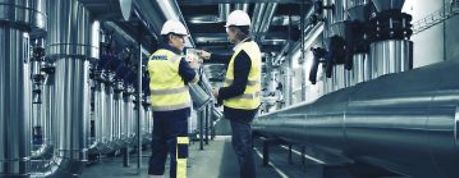ANDRITZ Belt drying system BDS
Municipal sludge drying and granulation using waste heat
The patented ANDRITZ AG belt drying system (BDS) is characterized by its flexibility and ability to use a wide range of energy sources, particularly low-grade waste energy. BDS can be used for drying a broad range of products, such as industrial and municipal sludge, cow manure, biomass, as well as pre-treated municipal solid waste.

Energy recovery from waste gas by means of a belt drying system for a cement factory in Karlstadt, Germany

3D model of the sewage sludge belt dryer for Grésillons, France
The strengths of the system
- Plant performance up to 10 t/h water evaporation per drying line - fewer lines, less maintenance, lower costs
- For capacities over 3 t/h, concrete dryer casing - robustness; no corrosion; no extra building required
- Low cost and easy maintenance due to the technical concept and easy access to all elements
- Simple operation with quick start and quick stop features
- Plant in full compliance with ATEX safety regulations
- High thermal efficiency due to air recycling rate for drying air
- Good adaptability to various sludge qualities due to variable backmixing
- All components operated under slight vacuum (dust and odor are kept inside the dryer)
The following additional advantages are achieved by using the waste heat recovery option
- No thermal energy cost, significant reduction of operating costs
- Sustainable solution with no influence by possible energy price rises in the future, conservation of primary energy sources
- Environmentally friendly concept, considerable reduction of greenhouse effect
- Optimum conditions for partial or complete integration of recycled exhaust heat, such as flue gas, steam, and hot water from cogeneration plants, waste incineration plants, power plants, and other processes
Safety box - the extra safety lever for belt dryers
The additional safety level operates independently of the plant control system. The safety box monitors all safety-critical parameters, such as dust, temperatures, and CO-levels. If the limit values are exceeded, this control device shuts down the plant immediately and initiates fire extinguishing by the sprinkler system. The safety box is assigned to SIL (Safety Integrity Level) category two, which means the box has very low failure probability.
Product path
Mechanically dewatered sludge and sludge that has already been dried are fed to a feeding/mixing screw. The mixed sludge (approximately 55-60% DS) is distributed over the entire surface of the drying belt by means of the feed module, which consists of a distribution and a recycle screw. The feed module can be adjusted to control the thickness of the material layer across the entire belt width (50-100 mm). The drying air is heated directly in a burner or indirectly in a heat exchanger. After passing through the drying zone, the product has a dry solids content of over 90% and is cooled down in a belt cooler. At the end of the belt, the dried product is discharged via a product screw conveyor and transferred for further use or back mixing.
Drying air
The drying air is heated to an inlet temperature of 120-150° C. The air flows through the sludge layer, absorbing the moisture from the product. To achieve optimum thermal efficiency, the dryer is operated with a high recirculation rate. Thus, a large amount of the drying air is recycled to heat generation and heated again. One part of the circulating air is transferred to the condenser and a chemical scrubber, where acidic and basic pollutants are removed. All dryer components are operated under low pressure, avoiding dust and odor emissions.
Heat generation
The dryer air is either heated directly by the hot gases produced by combustion of natural gas or indirectly by heat exchangers utilizing waste energy from various processes, such as exhaust gases from cement kilns, waste-to-energy plants, gas turbines or gas motors for power plants, as well as hot water from gas motors. In a combustion chamber the hot gases from the gas burner are mixed directly with the cooled dryer air and routed back to the dryer. In the case of waste heat, the dryer air is heated indirectly by a heat exchanger usually positioned at the top of the dryer. The dryer air passes through the wet sludge layer and cools down again. The surplus vapors produced by the evaporation process are cleaned with the condenser and optionally, with an exhaust air cleaning system. Due to the arrangement of the fans after the drying belt, all dryer components and ancillary facilities in contact with sludge or product to be dried are maintained at a slight negative pressure. As a result, no dust or odor can be emitted to the environment.

